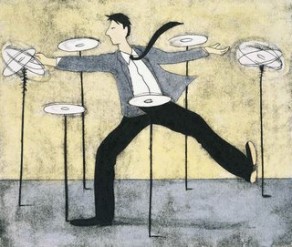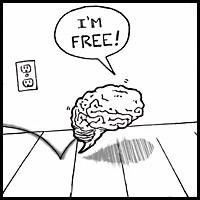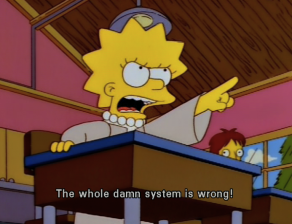Becoming a nomad – and I imagine any other life-changing project – comes with an extraordinary amount of things to do. In my previous posts, I wrote about the benefits of splitting tasks relating to the new and the old lives. In this post, I want to share with you my second time and task management trick: GTD.
Getting Things Done (GTD) is a productivity system that helps me and thousands with me to do exactly what it says: get things done. I used GTD to organize my life long before I decided to become a nomad. The system made a real impact on the amount of stuff I got done while simultaneously reducing the stress involved in doing them, and I bet it can do the same for you.
Enough preamble. Let’s get some stuff done!
So what is this GTD business?
Getting Things Done is the title of a book written by David Allen. It became incredibly popular among life hackers, to the point of becoming a cult. It is hard to believe how a glorified to-do list can get the sap rising, until you try it out. Before you know it, you find yourself writing blog posts about how good it is.
As cults go though, GTD is quite benign. There is only one cheap (~£7) book to buy, and as far as I know, there is no need to perform any blood sacrifices in the name of either Mr. Allen or productivity.
Free your brain
Your brain is amazing. No, really. This is not the worst pick-up line ever. (OK, it is. Don’t use it!) It is a fact. Brains are creepily creative and able to make the most surreal conceptual leaps that thrust humankind towards glory. (Peanut butter and jelly? I mean, wow! Who would have thought?)
It is a crying shame to waste this blob of fat and synapses on keeping track of your ‘stuff’. When I say ‘stuff’, I mean all of those things your brains thinks you should do, now or sometime in the future. I will be using this word a lot.
Your brain is not even good at keeping track of stuff! It is a self-doubting over-achiever. Our subconscious is constantly keeping tabs on stuff that we should not forget. It is like a plate spinner, constantly running from plate to plate to give them a bit more spin and keep them from falling. It is amazing that it gets any time to do anything else. Apart from being a waste, it is also stressful.
So how do we free our brains from having to keep tabs on our ‘stuff’ so it can go and do something great, like curing cancer? Simple. You free it from the responsibility of keeping track of your ‘stuff’ by externalizing it into a system. Enter stage left — GTD!
So how do I capture this stuff?
Do you recognize this situation? You have had a moment of inspiration and created a nice to-do list. You look at it from time to time and your brain slide right off it like it had been made of Teflon. The procrastination monster in the back of your head gently guides you to the TV instead, and the poor to-do list remains as incomplete in the evening as it was at breakfast. What went wrong?
You may have had an item like this one:
- Do your taxes.
Well, what is the problem with that? The problem is that it is not one task but many, all rolled up in one vague goal. The first thing you need to do when confronted with a ‘task’ such as that is to think. When you are in a doing kind of mood, you don’t want to think; you want to do. That why it is a ‘to-do’ list, not a ‘to-plan’ or ‘to-think’ list.
Doing your taxes is also a behemoth of a task. When something seems too big to complete in one go, we push it to the future. Where is the fun in working for a couple of hours and not getting the satisfaction of ticking anything on your list?
So, when confronted with a goal such as ‘Do you taxes’, set it down as a project and then think of the next concrete action you have to do to complete it. For example, it could be like this:
- Print form A-904.
Is it concrete? Yes. Do we need to do any thinking before we set to work? No. How long will it take? Maybe five minutes. Do you think that you will do it if it stares you in the face? Why not? You can do it while the next streaming episode of Buffy finishes buffering!
One last note on how to capture your stuff. Make a note of where you need to be or what you need to have at hands in order to do the task. This is called the context of the task. For example, say that I need the internet and a printer to print form A-904. I have internet at home and at work, but I only have a printer at work. Well, note down ‘work’ as a context.
- Print form A-904 (work).
When you are in one of your contexts (e.g. work) you can look at only those tasks that you can do and ignore the rest. The aim is to filter out that which you can’t do in order to better focus on what you can do. Other common contexts are errand, home, online, phone, bank etc.
Trust the system
You’ve done it! You purged your brain of all your stuff and put it into your system. You have an awesome list of projects and tasks. Your brain is free to do some creative work, now that your GTD system is your brain’s personal assistant that keeps track of your tasks. Your brain has never felt so light in your head and the sun is shining.
How long does it last?
I can tell you when it stops. It stops the second your brain suspects that your system isn’t to be trusted. If your brain gets even the most whimsical wisp of watered down what-if-the-system-doesn’t-work suspicion, it will snatch back responsibility for your stuff so quickly that your head will spin as fast as your plates.
To keep this from happening, you need to review your system once in a while to make sure that it is up to date and complete. Thirty minutes on Sunday morning works well for me.
During this review, ensure that your brain isn’t spinning a plate somewhere in the background. If it is, take the plate away from it and put the related task into your system. This is also the time to go over your task list and make sure that you have seen it all. This is important. If your brain knows that you will, without fail, keep tabs on your stuff at least once a week, then your brain never has a reason to doubt you and start doing this for you. It trusts that nothing can get ‘lost’. It trusts that your system is better than it is at spinning those plates, and your brain is free to think about other things that might go with peanut butter.
The artist, the executive and the grunt
A blog post can never have too many analogies, so here is another one.
We humans are not constant. We change our moods throughout our days, and so at different times we are better suited to do different kind of work.
Sometimes we are dreamers who idly think up cool stuff that we would like to do. We are artists then who think big with little consideration for whether the thing can or even should be done. The GTD system loves our little artist and suggests we prepare inboxes for the little guy. The artist can make a quick scribble that it would like to paint both the living room and the clouds pink and pop it into the box.
At other times, we put on the suit of the executive director. This is our sensible and thinking guy who doesn’t come up with ideas and certainly doesn’t do any work. No, this guy makes decisions and plans. He will look at what the artist has thrown into the inbox – Paint the living room and the clouds pink! – and process those ideas into the system of projects and tasks. So in our example, he would discard the project of painting the clouds pink as both impossible and tasteless. The painting of the living room though is a fine project, he decides, and makes that a project. He also thinks out the very next action which is to pick up some colour samples from the DIY store.
Project: Paint the living room pink.
Next action: Pick up colour samples from DIY store. (Errand)
And of course, nothing would ever get done if the world was run by artists and executive directors. We need to be a grunt at times and get our hands dirty. This is the guy who does whatever it says on the next action list. It is amazing how quickly you can do stuff when you don’t need to think! Boom boom boom! Before you know it, all of your errands are done in one afternoon, thanks to them being lined up in one place with all pre-requisite thinking already taken care of. Your grunt returns home with a whole swatch of pink nuances in his triumphant hands!
Summary
The main points of GTD are:
- Your brain is great at creative work.
- Your wonderful brain is not only wasted if it is put to keeping track of what you should get done, but it is also a source of stress. Therefore, you should externalize the job of task tracking into an external system.
- For the real effect, you should capture all your tasks in that system.
- Your brain will know if your system is not water tight and immediately resume the job of keeping track of your tasks for you.
- Avoid vague tasks descriptions that are actually goals. Ensure each task is a single concrete task.
- Separate task generation (the artist), prioritization and planning (the director) and execution (the grunt).
The beauty of GTD is that it is light and simple. Still, there is more to the system than I can cover in this post. Read the book to get the rest. I can’t recommend the system enough. It made my life much more organized, simpler, reliable and most important of all, less stressful.







Getting Things Done was written by David Allen not Roger!
You’d think I could get the author of the book right, wouldn’t you? Thanks for the catch. It has been corrected. For the rest of you, Roger is a guy at UBS and I don’t think he has written a book.
… but perhaps he should
No book, but thank you for the name check 🙂
Following your adventures with interest.
While perusing your awesome picture of nomadic culture, my mind stopped cold on one item: Getting Things Done. As a person with way too many spinning plates, and a very active imagination, my subconscious is always on the lookout for a better way to manage my chaos (traveling back and forth across the Atlantic once a week (jetlag!), caretaking a disabled and mentally ill parent (insanity!) and being a landlord (calls from the police) to name a few that aren’t even fun projects like trip planning. So I downloaded it. Now I have spent hours and money at a very good therapist, taken classes in meditation, and I NEVER HAVE DONE ANYTHING TO un-STRESS MY BRAIN LIKE THIS BOOK! And I’m only half way through! Just collecting projects and to-dos in a huge brainstorming giant list was liberating. I haven’t even begun to establish a complete personalized system yet (how much pen and paper and how much tech?). But I see “NIRVANA” looming before me. I will have to buy two GTD books. One for me to mark up and page bend. And one to give as a gift to the woman who organized my Mom’s basement, if she doesn’t already have it. I’ll try and by it from your link Gustav if you promise to use the stamp to send me a weird postcard some day.
Gustav, your brain is amazing. No, really.
Hej Gustav!
I´ve tried all GTD software out there, and Nirvana is the best online system!
But, I´m now using Omnifocus, on my Mac, iPad and pod, Omnifocus is “hard core GTD” and outstanding!
Kul att läsa om en smålänning som blir en Nomad, lycka till! =)
/Mattias
Gustav,
Your post about GTD is a simplified and fantastic article in my opinion. As simple as GTD is, most people complicate the process once they feel more organized. Somehow they forgot how they became organized and start to believe it was some genius idea they must had implemented on their own. Explaining GTD is not that easy and you did a great job of it.
Ha, I have actually downloaded this book multiple times but have never gotten around to actually read it. Now that´s what a REAL procrastination monster looks like, folks… Maybe I should give it another go. I just hope your taste in organizing systems is better than your taste in movies.
OK, ladies and gentlemen, let me introduce Martin Johansson, a dear childhood friend and the worst procrastinator in the world! GTD vs. Martin. Oh dear god, I can’t look!
When we first met we had a laugh that I had owned the GTD book for a year and a half but had never made time to read it (definite procrastination, like Martin). When I finally decided to read it I realized I couldn’t even find it so I had to buy a second copy. This was right about the time we had our talk in London about your decision to live a nomadic life. I’ve now read it and love the concepts. I think it’s one of the only things keeping me sane in the hectic technology world I spend most of my time in.
Hey Mike! I can’t help but share how we met. It involves GTD.
I sat at a cafe in San Francisco (Squat & Gobble!) and worked on designing a mobile implementation of GTD. I guess I was conspicuous because Mike, sitting next to me, started talking to me. That conversation made me realize that I had more career options than I had realized, and that realization was a factor in my decision to become a nomad.
The importance of random meetings should never be underestimated.
For implementing GTD you can use this web application:
http://www.Gtdagenda.com
You can use it to manage your goals, projects and tasks, set next actions and contexts, use checklists, schedules and a calendar.
Syncs with Evernote and Google Calendar, and also comes with mobile version, and Android and iPhone apps.
Thanks for this tip and for the book tip. Just recently began reading the book, and starting on the GTD-organizing. This combined with working towards the minimalism has really changed so much of my life. Love it! Thanks!
This is one best GTD overviews I have seen… And I have seen most of them!
For my personal GTD workflow, I took the path of a simpler than the official GTD flow, Zen To Done. I use a combination of Evernote and Things to manage my data and tasks. I can’t imagine life without such a system!
-Scott
PS: I love trolling your blog dear Gustav! I do whenever I have down time. Xoxo
Hi Gustav!
Fun write up of GTD. So glad it’s helping you in your adventures of Nomad-ness!
Kelly
(senior Coach w/David Allen Co.)
Si todavía tenés interes en herramientas para usar con GDT (¿o tendría que decir HTH [haciendo las tareas hechas]?): yo sigo usando OmniFocus for iPhone / iPodTouch / iPad ya por más que 2 años y me reconviene este programa. si querés te lo puedo mostrar un día.
ergh… y ahora: ¡a revisar mis tareas para la semana que viene!
Thanks Gustav! I really appreciated your GTD write up and it inspired me to get started with GTD. I’m just getting started, but the results are immediate and I’m liking this new “shift” in getting things done. By the way, I’m also enthralled with the rest of your blog. I’m so glad I found it. Thank you for all you share.
I’m thrilled that I got someone to try GTD. I have used it for two years now and I couldn’t imagine structuring my stuff any other way.
The key to keeping it up is sticking with the weekly reviews. After each such review, that feeling of calm control is reasserted.
Please help me reach more people with the GTD gospel by sharing this post on whatever social media you are on! 😉
How do you keep track of all of the tasks or your system? My problem is I start but don’t follow through. I tried keeping a notebook but hasn’t worked for me.
http://www.nirvanahq.com – It is brilliant! And of course, I do a weekly review of my GTD lists. After a while, it becomes routine. Also, you get used to the low level of stress that GTD gives you. Any time that I slip up and don’t catch my stuff in my GTD system, my stress levels rise and won’t go down until I’ve once again got everything going through GTD. Seriously, this is a godsend!
The best raw post about human behaviour against organization and how to GTD can help if implementation keeps simple and minimalistic over time.
Thank you! I still use it and still use Nirvana, so for me it has proven itself over time.